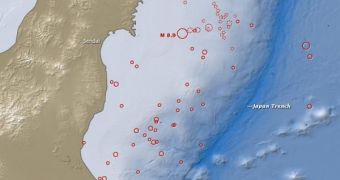According to the conclusions of a new scientific study, it would appear that the March 11 Tohoku Earthquake that struck Japan also had a tremendous impact on an upper layer of the planet atmosphere, called the ionosphere. Experts say that they did not expect to find such an effect.
The study comes on the heels of another research released just a couple of days ago, which shows that the tsunami produced by this catastrophic event contributed to the calving of glaciers from an Antarctic ice sheet, all the way across the Pacific Ocean.
As such, geologists, seismologists and planetary scientists are beginning to piece to gether the image of a megadisaster. The earthquake was so strong that it caused effects no one knew were possible, and also triggered numerous other small tremors all around the world.
On the bright side of things, the investigators who conducted the new work say that the data may inform the creation of new advanced early warning systems against both tsunamis and earthquakes.
In previous studies, experts demonstrated that it's entirely possible for tremors to cause waves extending all the way into the atmosphere. During the March 11 catastrophe, the atmospheric waves that were triggered were massive, the team reports.
They reached all the way to the ionosphere, a layer of the atmosphere extending from around 85 to more than 600 kilometers above the surface of the planet. The layer comprises sections of Earth's mesosphere, thermosphere and exosphere.
The disturbances produced by the Tohoku tremor reached an altitude of more than 220 miles (350 kilometers), scientists write in June 28 online issue of the esteemed scientific Journal of Geophysical Research-Space Physics.
Experts refer to these perturbations as seismotraveling ionospheric disturbances. In this case, they were discovered using a network of more than 1,000 Global Positioning System (GPS) receivers. The devices were located in both Japan and Taiwan, Space reports.
“This signature in space that we can see with GPS could provide early warning that a tsunami is coming,” expert Jann-Yenq Liu says of the possible applications the new study has. He holds an appointment as an atmospheric scientist at the Taiwan National Central University.
“Is there any detectable precursor in the status of the ionosphere before this disturbance is actually observed?” Duke University atmospheric physicist Gaopeng Lu asks. “In that way, we might be able to predict the occurrence of earthquakes,” concludes the expert, who was not a part of the study.

 14 DAY TRIAL //
14 DAY TRIAL //